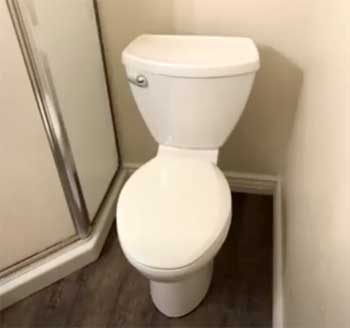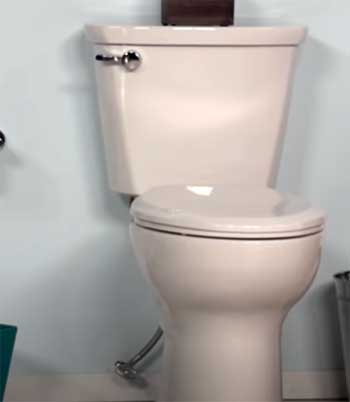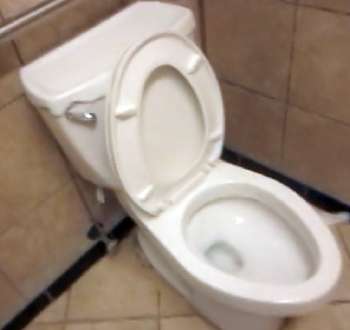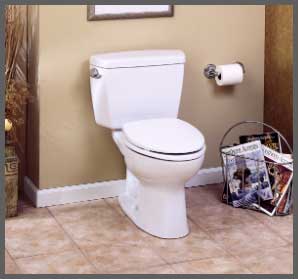If you’re debating between the American Standard Cadet and Champion toilets, you’re on the right page.
I’ve installed both in real homes and tested their flush power, tank mechanisms, and everyday function.
This review covers what sets them apart and which one fits your household needs best.
Comparison Table: Cadet Vs. Champion
| Feature | American Standard Cadet | American Standard Champion |
| Flush Strength | Powerful, siphon-based | Industry-leading strength, clog-proof |
| Flush Volume | 1.28 gallons per flush | 1.6+ gallons per flush |
| Trapway Size | Standard 2-inch | Oversized 3-inch for easier waste passage |
| Bowl Height | Standard and comfort height options | Comfort height primarily |
| Flush Mechanism | Fluidmaster or 3-inch canister | Larger canister with enhanced flushing |
| Clog Resistance | Good for common use | Excellent on heavy and fibrous waste |
| Price Point | Mid-range | Premium |
| Design Aesthetic | Simple, classic lines | Sleek, modern profile |
| Warranty | Standard limited warranty | Extended warranty available |
My Real-World Use: Cadet Then Champion

I first installed the Cadet in a rental property. It handled normal use well—liquid waste flushed cleanly, solid waste typically went down on the first try.
Occasionally, guests had to double-flush after bulky loads. Maintenance was predictable, the fill valve worked fine, and the compact design fit nicely under the sink with room for plumbing accessories.
When I remodeled my master bathroom, I upgraded to the Champion. Right away I noticed bulkier flushes didn’t stall.
No more double-flushing, even when kids tried to flush toilet paper balls. The oversize trapway and 3-inch canister made an impressive difference. Sound was a bit louder on flush, but it cleaned more decisively.
After monthly cleaning and occasional tank lid checks, both performed solidly.
But the Champion felt more durable—my plumber mentioned fewer callback calls for clogs over time.
Today I use the Cadet in guest bathrooms and Champion in daily-use bathrooms. It’s a clear see-saw between value and performance.
Real-World Flush Testing: Everyday Challenges and Surprises
One thing I really like doing when testing toilets—yes, I test toilets seriously—is putting them through real-world, day-to-day challenges.
We’re not talking lab simulations. I’m talking about large paper loads, occasional kid-related “experiments,” and those surprise family visits when the bathroom gets more use in one day than it usually does in a week.
With the American Standard Champion, I didn’t experience any clogs, even when someone tossed in a bit more tissue than necessary.
The wide flush valve truly plays a role here. It created a powerful swirl that cleared the bowl quickly.
On the other hand, with the Cadet, I noticed it sometimes required a second flush when the bowl wasn’t entirely clean, especially during the busier days.
Noise levels were also worth noting. The Champion is more forceful and makes its presence known.
If you’re flushing late at night in a quiet home, you’ll hear it. The Cadet, in contrast, is much quieter—probably a better pick if you live in an apartment or have a baby’s room next to the bathroom.
In short, when tested in real, unpredictable situations, the Champion felt like a workhorse.
The Cadet handled the basics beautifully but stumbled slightly when things got intense. Depending on your household habits, that could be the detail that tips your decision.
Cleaning and Hygiene: What I Noticed After Weeks of Use

After a few weeks of use, you really start noticing how much effort you need to put into cleaning your toilet.
At first, I didn’t expect there to be a big difference between the Cadet and the Champion.
But once I stopped cleaning them both manually for a week (just to test), I started seeing how each handled build-up and bowl cleanliness.
The Cadet has a decent bowl rinse, but it wasn’t quite as thorough as the Champion. The Champion’s stronger flush seemed to leave less behind.
I found that after just five days, the Cadet bowl had light rings forming and needed a quick brush-up, especially near the waterline. The Champion? Not perfect, but noticeably cleaner.
Another hygiene win with the Champion was the bowl glaze. It felt smoother to the touch when cleaning (with gloves on, of course), and waste didn’t seem to cling as much.
For anyone trying to cut down their cleaning time, or dealing with hard water, that’s a big deal.
I’ll say this though—the Cadet is still a well-built toilet, and if you stay on top of regular cleaning, you won’t have problems.
But if you’re looking for a toilet that saves you a few extra scrubbing sessions per month, the Champion has the edge.
Pros and Cons of Cadet and Champion

Pros:
- Cadet: Affordable and reliable for everyday use. Offers a clean flush and low-profile design. Easier to install due to standard parts and sizing. Good water efficiency with 1.28 gallons per flush.
- Champion: Exceptionally powerful flush thanks to 3-inch trapway and large flush valve. Great for large households or heavier use. Significantly fewer clogs. Comfort height models offer better user ergonomics.
Cons:
- Cadet: May require double flush on bulky waste. Trapway can occasionally clog with fibrous or heavy material. Standard seat height may be less comfortable for some users.
- Champion: Higher price. Flush is louder due to force. Bulkier tank and rougher fit in smaller bathrooms. Replacements for unusual parts cost more if needed.
Maintenance Tips for Both Models

Keep the fill valve clean by flushing tank water into a bowl occasionally to clear sediment.
Tighten bolts under the tank periodically to prevent leaks or wobble.
Use non-abrasive cleaners to preserve the bowl and tank finish.
Ensure water level sits at manufacturer fill line for proper flush force.
Use a soft brush to clean the rim before flush holes to avoid clogging jets.
Check for seat bolt tightness once a year to prevent rocking or leaks.
Flush twice monthly with plain water to prevent buildup of mineral deposit in trapway.
Replace flapper valve every 3–4 years if it begins to stick or leak.
Avoid flushing wipes, diapers, or sanitary items even if Champion seems powerful.
Seal between toilet base and floor with wax ring properly to avoid seepage over time.
Champion Vs. Other Brands
- Champion Vs. Kohler Wellworth

When I compared my American Standard Champion to a Kohler Wellworth, it became clear that Champion excels in performance.
In everyday use, Champion’s 3-inch trapway and oversized flush valve meant fewer double flushes and fewer worries—even when disposing of heavier or damp toilet paper loads.
By contrast, the Kohler Wellworth, while quieter per flush and offering sleek styling, occasionally required multiple flushes for bulkier waste.
If you’re someone who lives alone or uses light repairs, that might be fine. But once guests started using the guest bathroom more frequently, I noticed that Champion handled everything with zero hesitation.
Additionally, the Champion’s ability to clear waste on its first flush translates into less water usage overall over time—even though it technically uses more per flush, you rarely need backup flushes.
Kohler uses quieter operation, but the Champion delivers confidence that the flush will finish the job, consistently, time after time.
- Champion Vs. Toto Drake

When installing the Champion in my master bath and sampling it against a Toto Drake, I noticed the Drake looked more refined with whiter porcelain and a sleek tank line.
It also made a softer flush noise, which initially impressed me. but when I tested flush performance with large volumes of paper or slightly damp loads, the Champion flushed more cleanly on the first try every time.
Drake performs well under moderate use, but Champion’s trapway and flush valve size gave it a clear advantage.
Fewer powder clogs, fewer rings around the bowl, and less need for a second flush made day-to-day differences noticeable.
While Toto prides itself on design and quiet performance, Champion’s raw strength and reliability in busy bathrooms won my vote after extended use.
- Champion Vs. Gerber Avalanche
My friend had a Gerber Avalanche installed in their basement bath and swore by its build quality. It had a solid flush and was less prone to noise than basic models. When I used my Champion upstairs, I found trash disposal tasks easier—Champion felt more robust and rarely missed.
Avalanche offers great value and sterling reliability too, but Champion edges ahead with consistent first-flush performance and comfort-height options that improve user ergonomics. Programmed flush mechanisms in Avalanche work fine, but can disengage with time or water pressure. Champion’s power flush remains stable even under shifting flow conditions or minor clogs—meaning you worry less and flush confidently.
Frequently Asked Questions (FAQs)
The main difference lies in horsepower and noise insulation. Evolution models are quieter and more powerful, with SoundSeal insulation.
¾ HP works for most homes. If you regularly grind tough scraps or use the disposal heavily, consider 1 HP for more torque.
With routine use and care, most InSinkErator disposals last 10–15 years, especially their Evolution line with stainless components.
No. Models differ by horsepower, noise features, build material, and accessories. Higher-end models offer more power and quieter operation.
Final Thoughts
If you want a toilet that handles daily use cleanly and efficiently, the Cadet series delivers reliability and simplicity. But if you prefer fewer clogs, stronger flush, and improved performance—even at a higher cost—the Champion series is worth investing in.
Whether you choose Cadet or Champion, you’ll be getting thoughtful design from a trusted brand. Match it to your kitchen habits and comfort level—you’ll be satisfied every time you flush.
